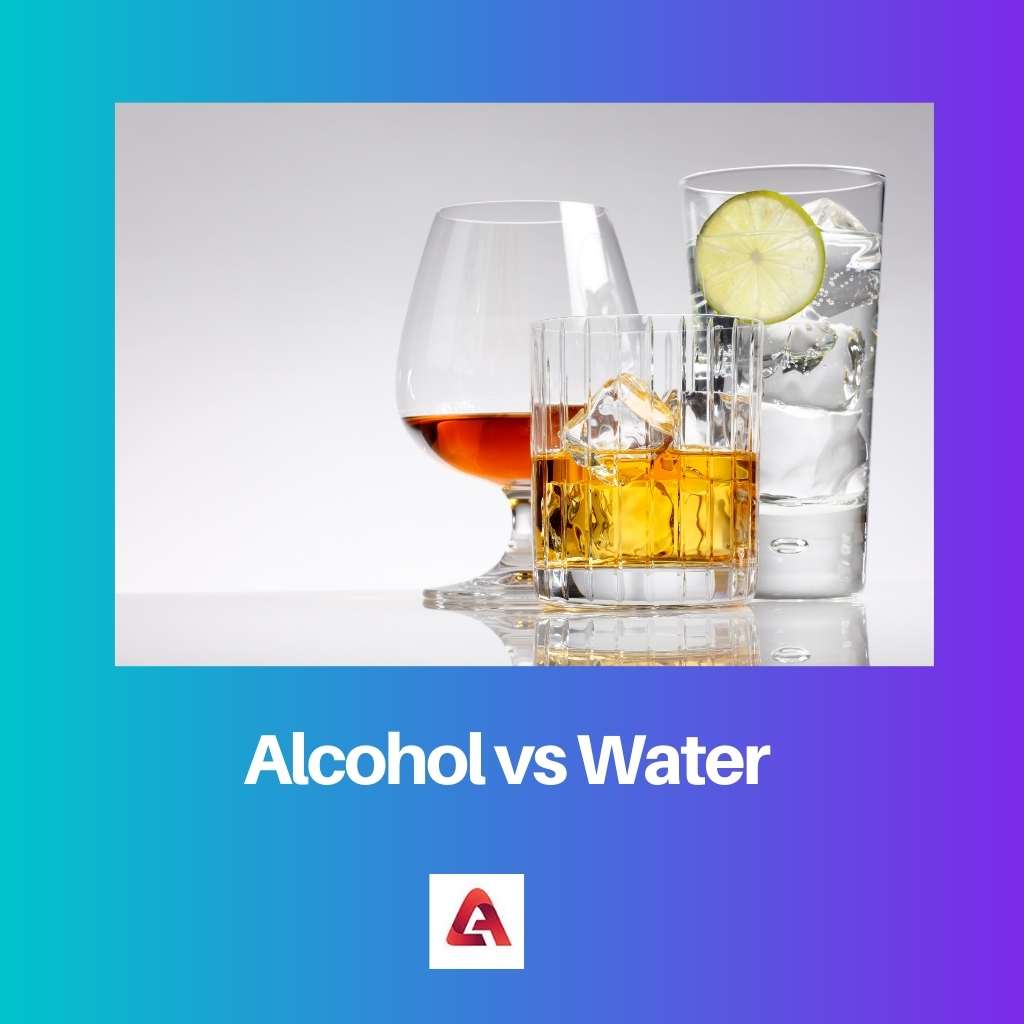No one can thrive in this world without water. Our bodies are composed of 60% water, demonstrating its importance.
Water is a type of molecular element, and it is the necessity of life, including humans, plants, and animals while alcohol is a chemical compound, and can be used for useful purposes (medical purposes and scientific experiments) or otherwise produce health issues.
Key Takeaways
- Alcohol is a clear, colorless liquid commonly used as a solvent, fuel, and disinfectant, while water is a clear, odorless liquid essential for life.
- Alcohol has a lower boiling point than water and is flammable, while water is not flammable and has a higher boiling point.
- Alcohol can be toxic when consumed in large amounts, while water is necessary for the human body to function properly.
Alcohol vs Water
Alcohol is a psychoactive substance that can affect the body, including reducing inhibitions, impairing cognitive and motor functions, and causing feelings of relaxation or euphoria. Water is essential for life. The body uses it for various physiological functions like digestion, excretion, etc.

Alcohol is a hallucinogenic substance that is present in alcoholic beverages such as beer and wine. Its chemical name is ethanol.
Alcohol produces various effects in the consumer including happiness, reduced anxiety, enhanced sociability, sedation, cognitive impairment. Humans can get addicted to alcohol, which can further lead to dependency.
Water is the primary ingredient of the Earth’s hydrosphere. It is an inorganic, clear substance.
It provides dispersion in the form of rain, clouds are made up of suspended drops of water, and water in its gas state is known as steam or water vapor.
Comparison Table
| Parameters of Comparison | Alcohol | Water |
|---|---|---|
| Chemical Formula | C2H5OH | H₂O |
| State of Matter | Exists only in the single liquid state | Solid (ice), liquid (water), and gaseous (steam or vapor) |
| Type of Substance | Alcohol is a chemical compound | Water is a molecular substance |
| Boiling Point | 78.37 °C | 100°C |
| Taste | Most alcoholic drinks have a slightly astringent taste | Water is tasteless |
What is Alcohol?
Alcohol, commonly recognized by its chemical term ethanol, is a psychoactive component present in alcoholic drinks.
Among other things, alcohol induces satisfaction and euphoria, reduces anxiety, enhances sociability, sleepiness, impairment of intelligence, and widespread depression of nervous system function.
Alcohol has a lot of detrimental short-term and long-term repercussions. Widespread cognitive impairment is one of the short-term harmful impacts, including confusion, nausea, purge, and migraine episodes.
Humans can become addicted to alcohol, which can cause drug abuse problems and dependency. Its intake is the sixth biggest cause of cancer and can have several long-term negative health repercussions, notably liver and brain impairments.
The favorable consequences of alcohol are caused by elevated levels of dopamine and endogenous opioids in the cortex’s rewarding networks. For about 10,000 years, people have created and continued to drink alcohol for its intoxicating effects.
Unlike many other recreational drugs, alcohol is socially accepted and legal in most nations. Nonetheless, there are frequently limits on the sale and usage of alcohol, such as a minimum drinking age and legislation prohibiting public drinking.
An intoxicated person quickly loses his senses, which is why he is not permitted to drive or work (in a drunken state). The way anything is used in this world determines whether it is valuable or destructive.
It is entirely dependent on the individual and how he employs it. Alcohol should be drunk in moderation since an oversupply of anything is hazardous and serves as a murderer.

What is Water?
Water (H2O) is an inorganic, clear, tasteless, odorless, and almost colorless chemical element that is one of the primary ingredients of earth and is present in all living species.
Even though it contains no calories or organic ingredients, it is essential for all known living organisms.
Its chemical formula, H2O, reveals that each of its molecules is made up of one oxygen and two hydrogen atoms that are linked together by covalent bonds. The hydrogen atoms are at an inclination of 104.45° to the oxygen atom.
“Water” refers to the liquid form of H2O at typical conditions of pressure and temperature. Water exists in a variety of natural conditions. It is essential to the global economy.
Humans use 70% of the freshwater available. Freshwater and saltwater fishing is an important source of sustenance in many places of the world.
Boats convey most of the long-distance commerce of resources (such as oil, organic gas, and manufactured goods) over oceans, canals, reservoirs, and rivers.
In industry and residences, large amounts of water, frost, and steam are utilized for temperature control.
Water is an excellent medium for a broad variety of organic and mineral compounds; as such, it is frequently employed in industrial operations, as well as in cooking and cleaning.

Main Differences Between Alcohol and Water
- The chemical formula of alcohol is C2H5OH, whereas H2O is the chemical composition for water.
- Alcohol is found in the liquid state of matter while water can be found in the liquid, gaseous and solid-state.
- Alcohol is a chemical compound meanwhile water is a molecular substance.
- The boiling point of alcohol is 78.37 °C and water has a boiling point of 100°C.
- Most alcoholic drinks have a slightly astringent taste while water is tasteless.

Water is involved in a wide variety of industries, making it a precious commodity.
Alcohol serves as a poison to the body, while water is crucial for life.
I’m not sure that comparing alcohol and water is entirely relevant. One is essential for life, the other should be consumed very cautiously.
The health implications of alcohol are far greater than any of its benefits.
We must recognize the importance of responsible drinking when talking about alcohol’s effects.
The social and cultural perceptions of alcohol are complex, and that impacts its acceptance.